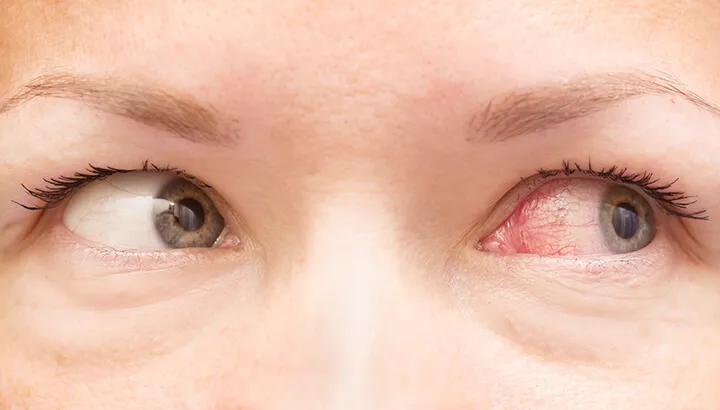The morning I woke up with pink eye is not one I’m likely to forget for a while. As my mind eased its way back into the conscious world, something weird was happening. My eyes wouldn’t open. For a few heart-stopping moments, I experienced what it must be like to be blind — try as I might, I couldn’t get my eyelids to separate. Stumbling into the bathroom and leaving toppled furniture in my wake, I was able to dab water onto my eyes until I could wrench them open once more.
The sight that greeted me in the mirror almost made me wish I’d never wrenched them open in the first place! Blood red eyeballs stared balefully back at me, confirming my teenage suspicions: I had a bad case of the pink eye. The upside? A perfectly legitimate reason to skip school for a few days!
Pink eye is a common condition in both kids and adults
My experience is an all too common occurrence amongst Americans, with pink eye affecting an estimated six million people in the United States each year. And while it may look a bit on the comical side, it’s no laughing matter. The cost of treating pink eye alone is estimated to range from $377 million to $857 million annually. That’s a whole lot of money, and a whole lot of working days missed.
So what the heck is it? Well, conjunctivitis, as it’s more accurately known amongst medical professionals, refers to “any inflammatory condition of the membrane that lines the eyelids and covers the exposed surface of the sclera.” Essentially, the outer membrane (or “conjunctiva”) that protects your iris, pupil and cornea gets infected and becomes swollen and inflamed. When inflammation of the conjunctiva occurs, these outer vessels dilate, turning a reddish color, and eject a discharge to protect the eye from further invasion.
That would explain why it was so darn difficult to wrench my opens that fateful morning — the conjunctival discharge had hardened to glue around the edges of my eyelids, sealing my poor eyeballs inside.
Because conjunctivitis is such a broad medical term, pink eye can be caused by a wide range of things. According to this study, viruses and bacteria are the most common infectious causes, while noninfectious causes of pink eye can include allergic reactions, toxic exposure and even as a side effect to certain inflammatory autoimmune diseases. Conjunctivitis can even be linked to sexually transmitted diseases like gonorrhea and chlamydia — perhaps one of the reasons why no one ever seems too keen to spread the word that they’re down and out with pink eye!
Is pink eye something to worry about?

Let’s get something straight: pink eye isn’t serious. In the majority of cases, doctors won’t even prescribe anything to treat it. Left on its own, it’ll usually be completely gone within seven to 10 days.
But some people can’t afford to stay away from the office, or indeed isolated from any human being, for that long. They’ve undoubtedly got places to go, things to do and people to see (provided they can wrench their crusty conjunctival eyes open in the morning). Time missed from work can also mean salary or wages lost, depending on your employer.
Not only that, pink eye is super annoying. This is speaking from experience. It often itches like crazy, and this is one itch which you simply cannot scratch. It also looks horrendous, causes your eyes to constantly leak, and is frustrating to deal with every morning. If you can, you want to get rid of pink eye ASAP.
And I have just the thing.
Natural remedy for pink eye
Activated charcoal can be used to quickly and effectively treat pink eye, all without a visit to the doctor’s office. Unfortunately, there’s no scientific evidence to back up this claim, but plenty of anecdotal evidence to demonstrate that activated charcoal is a very effective way to get rid of pink eye, without any nasty side effects.
Using charcoal to treat pink eye is perhaps most famously reported by a couple who moved into a village in Papua New Guinea and discovered that pink eye was running rampant amongst its inhabitants. They quickly set to work in spreading the word about infection, but it was no use — they inevitably also came down with pink eye within days. But by using activated charcoal, they were able to not only recover from their own symptoms almost overnight, but were also able to pass the remedy on to the other village inhabitants.
How to use activated charcoal for pink eye
As with many natural remedies, using activated charcoal to treat pink eye is super easy. Here are the instructions:
1. In a bowl or large cup, mix a teaspoon of activated charcoal (don’t just use the stuff from your fireplace!) with half a cup of water. Filtered or bottled water is best.
2. Once mixed in, pour the activated charcoal and water solution through a coffee filter into another bowl to strain out the solids.
3. Use an eyedropper to put two to three drops of the solution on your or your family’s eyes three to four times a day. If you don’t have an eyedropper, you can simply stand over a faucet and gently pour some of the solution onto your eyes.
If you administer the activated charcoal mixture enough times during the day, it should be gone within 24 hours.
When you need to see a doctor for pink eye
It’s important to recognize when you or your affected family member needs to see a doctor. Typically, if your pink eye hasn’t gone away within 10 days, or if your activated charcoal treatment hasn’t been effective over the course of two days, you should consider heading in to get your condition checked out. It could be a harder-to-treat case of pink eye, such as allergic conjunctivitis, which often needs to be treated with topical antihistamines.
— Liivi Hess

